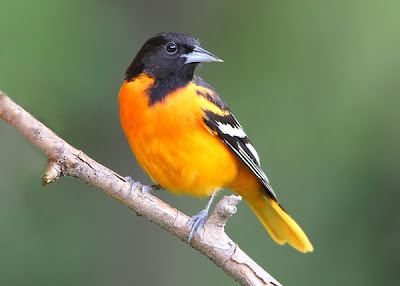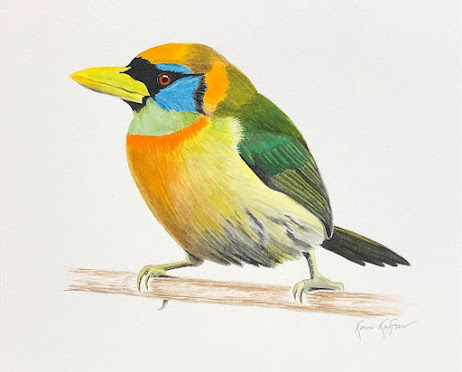Sharing the Joy of Birding: It's easy!
 |
| For a first-time birder, something like a male Baltimore Oriole, shining in the sun, can be worth its weight in golden feathers. |
Getting more people to care about birds and nature is vitally important. Over the years we have taken many hundreds of people out on their very first bird walks, so we've had a chance to see what works and what doesn't, and we wanted to share some results of our experience.
How do you make sure that someone will catch the spark and develop a lasting interest? We sometimes use the analogy of teaching people how to swim. One approach is to just throw everyone into the deep end of the pool; some will drown, but others will adapt quickly and will learn to swim quite well. The latter approach might be okay if we were just trying to create a few champion swimmers (or birders). But for the sake of conservation, we need to inspire just as many new birders as possible - including those who will only have a casual interest, dabbling in the shallow end of the pool. Their casual interest is perfectly valid and worth celebrating, and their support for conservation is crucial. So if you're taking people out birding for the first time, you should think about the experience from their viewpoint, and make it as rewarding as you can.
To try and encourage more people to reach out and introduce birding to someone new, we've developed a set of pointers on "First-Time Birding: How to take someone on their first bird walk."
1. You don’t have to be an expert. To take someone birding for the first time, do you have to know every bird you see and hear? Absolutely not. If you’ve been birding for at least a few weeks, then you already know more than someone who’s never tried it. It’s okay if you see something that you can’t name; just admit it up front with some brief explanation (like, “I don’t do flycatchers yet”) and go on to the next bird.
2. Choose your place and time carefully. In some situations, birds are tough to find. In others, birds are out in the open, easy to see. When you’re deciding where and when to take someone birding for the first time, it’s important to go for the latter kind of scene.
Big waterbirds offer good possibilities: big herons and egrets close to a road, terns and big shorebirds on a beach, or a good variety of wild ducks on a pond, for example. Birds often become easier to approach in city parks or public beaches than they are in wilderness areas, but you need to scout the area to make sure the birds haven’t been crowded out. If no big waterbirds are available, you might find a good variety of birds coming to feeders at a nature center. Or you might walk a trail along the edge of a meadow that has bluebirds, buntings, and others. The important thing is to have some nice-looking birds that are easy to see.
 |
| Buffleheads are not rare birds, but an obliging pair on a park pond just might spark someone's interest in birds of all kinds. |
3. Don’t get hung up on looking for something “good.” Years ago, Kenn took a group of business managers out birding in New York’s Central Park. It was the end of spring migration, and Kenn was worried that he wouldn’t be able to show them much. He needn’t have worried: these managers were captivated by the glossy colors of grackles, by the flashy behavior of Red-winged Blackbirds, by the intricate patterns of starlings. Don’t underestimate the power of common birds to fascinate the first-timers. When you’re trying to get someone new excited about birds, a rare (but drab) species of sparrow isn’t worth nearly as much as a common (but flashy) oriole or goldfinch.
 |
| Red-winged Blackbirds may not be exciting to longtime birders, but for a person looking at them for the first time, they can be pretty impressive. |
5. Don’t worry about running up a big list. Most people new to birding will be amazed if you can show them twenty species of birds—even if you’re in a place where you know you could find a hundred. It’s okay to point out distant flying birds, or the voices of hidden birds, just to indicate that there are more things around. But the focus should be on the birds that the first-timer can see or hear very clearly, even if those add up to only a fraction of the total possibilities.
 |
| When you're just starting out, a really good view of a cardinal beats a distant, sketchy look at any rare bird. |
7. Make sure they know what to expect. Establish ahead of time how long you’ll be out: usually a couple of hours will be plenty for a first birdwalk. (If everyone is having fun at the end of that time, you can always decide to keep going.) Tell them how far they might have to walk, over what kind of terrain. Let them know about anything like the need for insect repellant (or better yet, avoid places where such would be necessary). Think about the availability of restroom facilities, shelter from weather, and so on. People who are comfortable will be better able to appreciate the experience of birding.
8. Have fun! Remember, birding is something that we do for enjoyment; anyone who enjoys it is a good birder. The important thing is for your first-time birder friends to have a good time!
 |
| Here's Kimberly with some brand-new friends at a National Wildlife Refuge in Florida. They saw some birds, but more importantly, they had a good time. |




The tip about big waterbirds being a good starting point is so true - when I worked at an environmental education center in Georgia, I regularly led bird walks for middle school students, and it was great because I had access to a pond that always had spoonbills, storks, herons, egrets, Angingas, various ducks, etc. on it. It made my job easy! Now that I live in northern Wisconsin it's tougher, because like you say, newbies aren't going to get as excited as I am about winter finches and what have you.
ReplyDeleteAfter a couple years I realized that I had "warmed up" on waterfowl. They're big, generally colorful or well marked, and STAY IN ONE PLACE. Excellent advice.
ReplyDeleteGreat advice! I'll be sure to use it.
ReplyDeleteThanks for this lovely post Kenn and Kim. I often take friends birding with me, but this reminds me to be a bit more assertive about it!
ReplyDeleteExcellent points all, and ones to remember not just for Pledge 2 Fledge, but for anytime we take non-birders out with us. On those occasions, it's about them, not us.
ReplyDeleteThese are solid guidelines that will serve new birders well. Thanks for putting this all together in one list!
ReplyDeleteAll good points.
ReplyDeleteI was able to introduce my cousin to birding. He's yet to write down what he sees, carries binoculars in one hand and a cigarette in the other but he enjoys it.
Some great tips here Kenn! Nice post!
ReplyDeleteThis is the kind of thing I do all the time!
I just had a 7 year-old girl on my cruise this morning pointing out Bald Eagles, Herons and "seagulls" to me, and paging through my field guide (Kaufman of course :D ) and showing me the birds she sees in her back yard.
I helped her with a few IDs and looking up a few of her backyard birds and showed her a couple new ones.
Hopefully she'll keep at it!
One small step at a time!
I love that you picked a shot of bufflehead to talk about easy birds to start with.
ReplyDeleteThat is the species that I kept seeing (while walking along the San Diego River in, you guessed it, San Diego) that was so distinctive and stylish (I am a minimalist and love black & white), I finally had to find out WHAT IS THAT BIRD?
And thus began my birding-for-fun/free hobby (vs. shorebird monitoring 'cause it was my (albeit awesome) job). =) And then I saw them in this little enclosure at the San Diego Zoo, super close, and my LORD they are stunning. SO iridescent!